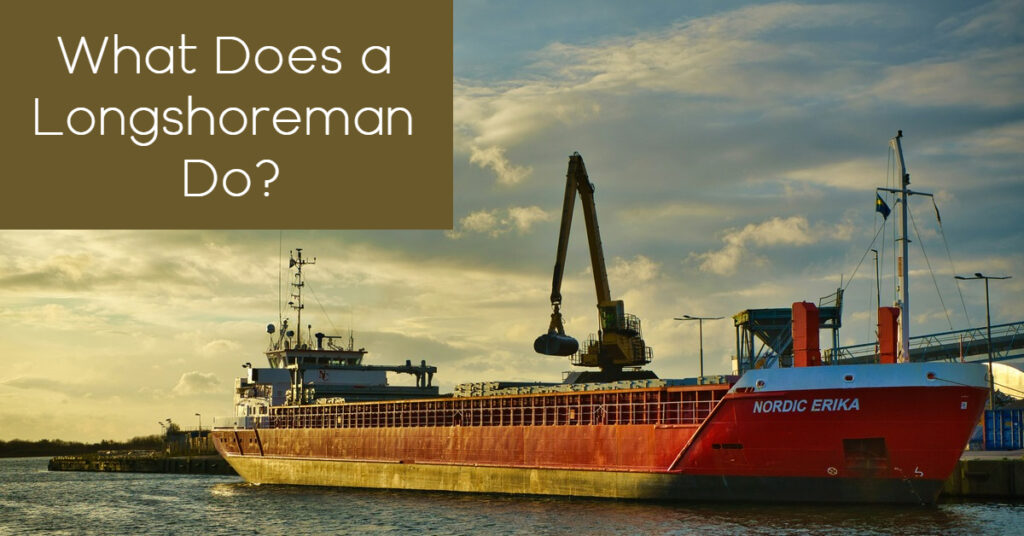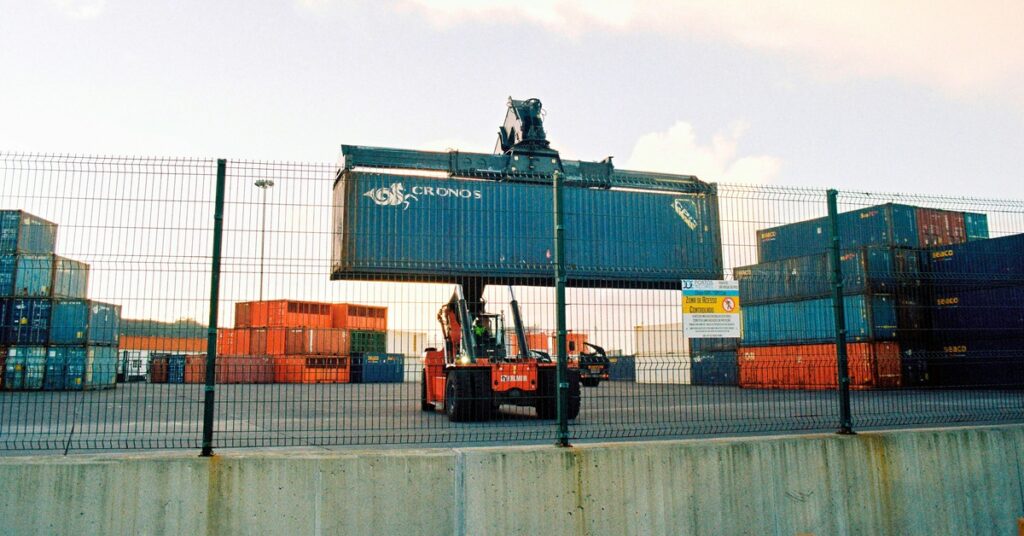Longshoremen play a critical role in the global supply chain. They move thousands of containers daily and synchronize their efforts with logistics companies, bringing billions of dollars worth of cargo into the country. So what does a longshoreman do?

What Is a Longshoreman?
A longshoreman is a maritime employee who loads and unloads cargo from ships docked at port. The name originates from the old days when ships sailing into the harbor would recruit “Men along the shore” to move goods from the vessel to the designated repository. Over the years, loading, unloading, moving and handling ships’ cargoes became collectively known as longshoring operations.
Before containerized shipping became mainstream, longshoring was labor intensive, requiring teams of skilled dockworkers. The work hours were long, irregular and often involved heavy, dangerous lifting, which is partly why the positions were only open to men. However, as trade and transportation have globalized, the industry has seen a growing number of longshorewomen. Around 8.3% of the nearly 5,000 longshoremen employed in the U.S. are female.
Is a Longshoreman the Same as a Stevedore?
While they operate in similar circles, they’re not the same. A stevedore is a person or company that manages ship loading and unloading operations. They typically own the cargo cranes and other handling equipment used by the longshoring workers at the docks. They also oversee correct haulage techniques and properly stow hazardous materials. Essentially, a longshoreman reports to the stevedore superintendent.
Stevedores also belong to a separate trade union from dockers, meaning they have different charters and processes for assisting members.
What Does a Longshoreman Do?
A longshoreman uses the appropriate equipment to maneuver loads of different weights and sizes on and off docked ships. The cargo is usually stored in metal containers ranging from 20ft to 53ft, which is where the standard benchmark of twenty-foot equivalent units (TEU) comes from.
Longshoring operations are integral to keeping the global economy running. America’s busiest seaport, the Port of Los Angeles, processed 8.63 million TEUs in 2023, accounting for hundreds of billions of dollars in revenue.
What Does the Job Entail?
Before using containers, longshoremen were dispatched in groups or “gangs” that worked together to tie cargo down with ropes before moving them off the ships. Moving heavy loads by hand from a slightly rocking vessel was especially precarious and required the utmost care.
The process is slightly different today with the introduction of advanced container handling equipment, but still incredibly dangerous. Nowadays, an employer puts in an order for how many longshoremen are needed for a particular job. The stevedore dispatches the workers to the site based on the type of work required and the number of ships.
Modern longshore workers handle various tasks beyond loading and unloading cargo between ships and docks. They check the cargo to ensure items match the shipping manifest and inspect them for damage. Everything is documented and forwarded to the relevant ground personnel.
Longshoremen are responsible for securing the cargo when loading goods onto the vessel to prevent the containers from shifting during transit. They also ensure the safe handling and storage of hazardous material before transport.
Every aspect of the job presents some risk. The equipment and containers are so large and heavy that even a momentary lapse can result in severe injury or death. CDC estimates show an annual rate of 15.9 fatalities per 100,000 workers at marine terminals and port facilities from 2011 to 2017.
Work Environment
Maritime work environments can be challenging. For instance, longshoremen often have to work in difficult weather conditions to meet scheduling demands. Sometimes, the job requires them to climb scaffolds and catwalks to fasten containers for shipping properly.
Vessels still sway slightly even when docked, which makes moving cargo with heavy machinery off or on them more difficult. The longshore workers often must deal with overhead crane operations at the harbor and follow all necessary precautions when handling containers.
Critical Longshoreman Skills
As with any occupation, longshoring operations require specific essential skills to get the job done right.
Spatial Awareness
Longshoremen must know how to judge distances and accurately maneuver cargo within confined spaces. It takes special training and experience to stack containers securely on ships or align them precisely on trucks to avoid overloading. Stacking requires proper techniques and a keen understanding of how different equipment can handle the weight and size of the storage cans. Longshore workers can stack up to 10 containers high on suitable land.
Cargo Handling
Loading and unloading cargo from ships efficiently requires the ability to operate multiple moving machinery under tight deadlines. For example, there are seven different forklift classifications, each with its unique application in shipping and warehousing operations. Longshore workers must balance speed with safety while moving items without damage.
Communication
Effective communication is vital for coordinating tasks and ensuring safety. For instance, clear communication between crane operators and ground crew is essential for smooth cargo handling operations, minimizing the risk of mishaps.
Safety Awareness
Dockers must constantly be aware of their surroundings and potential hazards. For example, they must be vigilant about slippery surfaces during rainy weather and ensure proper cargo rigging to prevent accidents like shifting loads or falls. They must also know OSHA regulations and procedures to avoid accidents and injuries. For example, adhering to protocols for working at heights or handling hazardous materials safely is essential.
Stamina
Longshoring work is physically demanding. Daily tasks require workers to be agile and have significant stamina. Aspiring dock workers must pass physical exams for endurance, coordination and eyesight.

Types of Longshoremen
The primary distinction in longshoring operations involves the frequency of work. Regular longshoremen are permanent, full-time employees at the port. They may have flexibility over shift schedules and ships or yards they work on. Regulars are registered union members, which gives them security and priority for available work.
Casual longshoremen are temporary employees who fill in when there is surplus work. They don’t belong to a union, so consistent shifts are not guaranteed and they have no control over work hours or schedules. Nevertheless, casuals are integral to the industry, as job demand can often surge without prior notice.
Gang Breakdown
Longshoremen work in groups of individuals with specific skills and responsibilities. The idea is to work interdependently to complete the job without additional assistance. Gangs typically comprise the following types of specializations.
Bosses
Every cargo loading or unloading job has an operations leader. They manage the process, ensuring it follows set procedures and doesn’t violate OSHA guidelines.
Dock Aloft (DA)
A DA oversees the operations of a specific equipment, communicating with the operator and providing directions from the dock, especially in blind spots.
Swingman
These versatile workers take care of various hands-on work as needed. For instance, they may assist with manually securing cargo onto trucks or conducting basic equipment maintenance. Their flexibility allows them to fill gaps and support smooth operations in various dock areas.
Lashers
Rough waters can cause ships to heave and yaw uncontrollably, which could cause containers to fall off. Lashers are responsible for securing the cargo to handle sea travel requirements.
Clerks
Clerks handle the administrative portion of the job. They document incoming and outgoing cargo details, such as quantity and destination, to maintain accurate records.
How Much Do Longshoremen Make?
On average, dockers in California make between $61,405 and $75,201 annually. Hourly pay amounts vary depending on the availability and complexity of the job. Workers earn wage increases based on the number of contract years worked.
Union membership can also affect their earning and salary increase rates. In 2023, the ILWU negotiated a 32% pay rise and a $70 million bonus for dockworkers in recognition of their heroic efforts to maintain the global economy during COVID-19.
Given the job’s dangerous and highly demanding nature, longshore workers deserve to earn reflective income.
How to Become a Longshoreman
Dockworking can be an exciting career path for people who work well with their hands and excel at team dynamics. The job does not require an official university degree, though candidates must demonstrate extensive shipping industry knowledge. Intending longshore workers must also meet the physical requirements before proceeding with their applications.
Obtain a TWIC Card
The Marine Security Transportation Act requires anyone needing to access seaports and wharves to have a TWIC certification. Candidates must be U.S. citizens or lawful permanent residents and at least 18 years old at the time of application. The process involves a criminal background check and threat assessment by the TSA before it issues the credential.
Join a Labor Union
The ILA and ILWU are great resources for finding available work. However, joining a union can be difficult, as these organizations rarely have open enrollment. Usually, candidates may join through affiliation with an existing member or wait a few years for an open spot. Nevertheless, this waiting period provides an excellent opportunity to upskill themselves and stay current on industry developments.
Sign up for Casual Shifts
Despite the erratic schedule and possibility of long spells without work, casual shifts are one of the best ways to gain firsthand experience. State union offices provide updates on work availability, so applicants must often stay in touch to pounce on the opportunity.
What Are the Advancement Prospects?
Roughly 1.95 billion metric tons of cargo ships across the globe every year, so there’s a good chance the industry will continue to need dockers. Entry-level positions typically start as dock workers before progressing to forklift operators, a coveted role due to the higher pay.
With experience, they can move to other types of machinery like cranes and terminal tractors or even to supervisory positions, such as gang boss or foreperson. Career advancement often depends on seniority and performance.
The Future of Longshoring Operations
Robot adoption is catching on quickly as companies try to improve their international shipping efficiency. Automated machines have become increasingly helpful in streamlining daily operations. For example, the mother-daughter cart system can reduce port traffic by 70% and increase the speed of loading containers onto ships without additional human effort.
Companies also use AI-powered software to optimize delivery routes based on real-time data input. This can lead to lower operating costs, minimal downtimes and improved customer satisfaction.
The proliferation of these technologies might spell some worry for longshoremen. However, it might take some time to replace jobs in the industry fully, especially since unions work so hard to protect their members’ interests. Nevertheless, potential candidates must focus on diversifying their skills and learning as much as possible about integrating digital innovations into their work.
Frequently Asked Questions
What is a longshoreman?
A longshoreman is a professional responsible for loading and unloading cargo ships at ports. They operate equipment such as cranes and forklifts, handle cargo and safely transfer containers between vessels and land.
What does a longshoreman do?
Dockers perform various tasks, including operating machinery to lift and move cargo, securing containers onto ships or trucks, conducting inspections and maintaining equipment.
How much do longshoremen make?
On average, they can earn anywhere from $50,000 to $75,000 yearly, depending on their skill and experience.
What are the working hours like for longshoremen?
Working hours can vary depending on factors, such as port activity and cargo schedules. Shifts may include days, nights, weekends and holidays. Some jobs also require overtime, especially during busy periods.
What skills are required to become a longshoreman?
The most essential skills include spatial awareness, cargo handling, communication and knowledge of safety regulations.
What are some challenges dockers face in their work?
The biggest challenges include working in hazardous environments, coping with irregular work schedules and navigating labor relations issues within the maritime sector.
- The Engineering Behind Ice-Class Vessels – September 20, 2024
- Is Maritime Security Necessary on Modern Ships? – September 11, 2024
- The Quality Control Process in Marine Manufacturing – August 28, 2024



